What is a bushfire? Overview, Causes, Effects, and Prevention
May you often hear common terms like wildfire, bush fire, and brush fire. Have you ever wondered “What is a bushfire?” How different are they? In this article, Weather365 is going to explain bushfires and the differences among others. Besides, factors contributing to more intensive fires and prevention tips are also disclosed. Let’s explore.
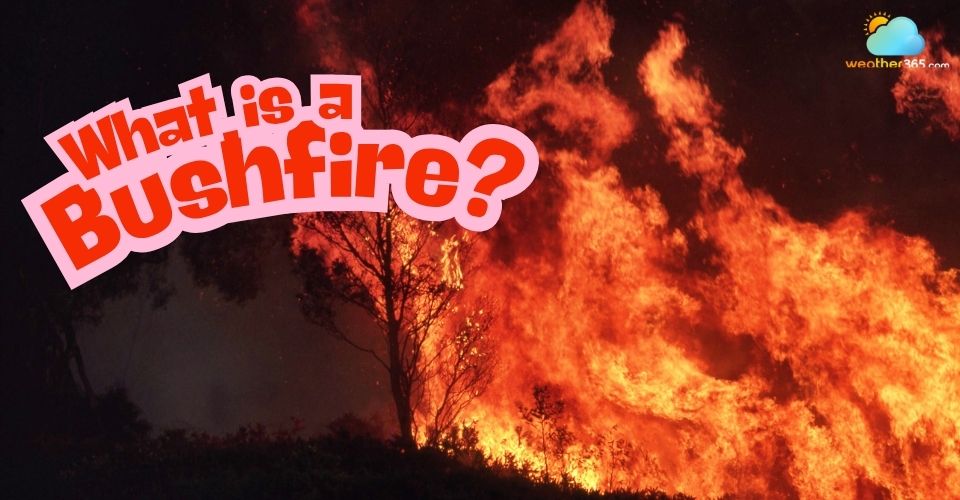
Understanding what a bushfire is
What is a bushfire?
A bushfire is an unplanned, uncontrolled fire that burns in grasslands, scrublands, or forests.
Bushfires commonly occur in places like Australia and parts of the US.
Fueled by dry vegetation, wind, and heat, these fast-spreading fires pose significant risks to communities, natural habitats, and ecosystems.
Climate patterns and rising temperatures contribute to bushfires, increasing their frequency and intensity in some regions.
Unlike controlled burns, bushfires are uncontrolled and destructive.
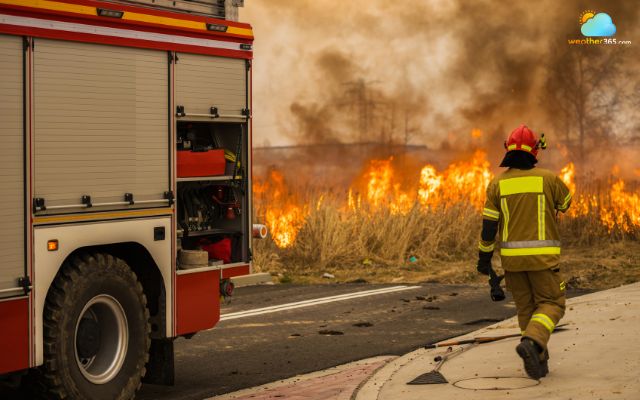
A bushfire is an uncontrolled fire that burns in grasslands, scrublands, or forests
Different names of wildfires
Mentioning bushfires, you may hear other common names such as wildfire, forest fire, brush fire, etc.
The term “wildfire” includes various types of fires, such as brush fires, forest fires, and peat fires. Each type affects ecosystems differently.
Brush fires burn through dense undergrowth, spread rapidly, and often precede larger forest fires.
While forest fire and wildfire are often used interchangeably, especially in Europe.
Australia commonly uses the term “bushfire”, reflecting its unique bushland ecosystems and localized terminology for fire events.
If you are wondering the difference between wildfire and bushfire, look at the table below.
|
Wildfire |
Bushfire |
|
|
Primary Triggers |
Mostly caused by human carelessness |
Natural causes such as lightning |
|
Ways of Spreading |
|
|
|
Local Terminology |
Mainly used in the United States |
Mainly used in Australia |
Factors contributing to bushfires
For a bushfire to ignite, the fundamental elements of the fire triangle must be present: fuel, oxygen, and a heat source.
Once a fire starts, its intensity and how quickly it spreads are determined by several key factors.
These include the ambient temperature, the amount and type of fuel load, how dry the fuel is (fuel moisture), and the wind speed and direction.
The steepness of the slope is also a critical factor, as fires spread significantly faster uphill.
Fuel load
Fuel load refers to the accumulation of fallen bark, leaf litter, and small branches on the landscape.
A greater fuel load typically results in a hotter and more intense fire.
Smaller, loosely packed materials like twigs and leaves ignite quickly and burn rapidly at the fire's front, while larger fuels such as tree trunks burn more slowly after the main fire has passed.
The natural oils in eucalyptus trees also play a significant role in promoting the combustion of this fuel.
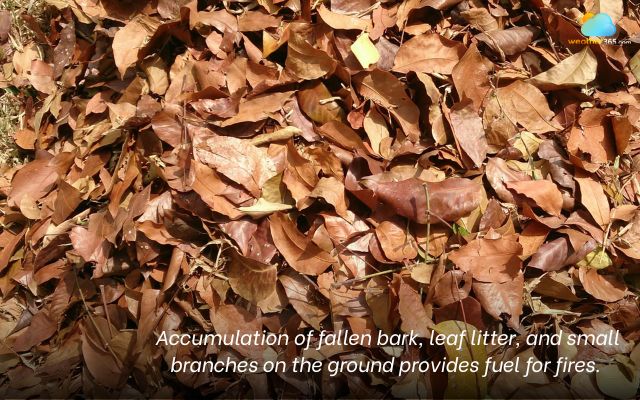
Fallen bark, leaf litter, and small branches on the ground provide fuel for fires
Fuel moisture
Dry fuel ignites easily. This makes rainfall history and moisture levels critical when assessing bushfire risk.
Experts often use indicators like the drought factor or moisture deficit to determine the likelihood of extreme bushfire conditions.
Wind speed
Wind drives bushfires by pushing flames into fresh fuel, supplying oxygen, and spreading burning embers that can start spot fires up to 30 km away.
Speeds above 12–15 km/h greatly increase fire intensity and spread.
Besides, wind shifts can quickly widen the fire front and accelerate its movement.
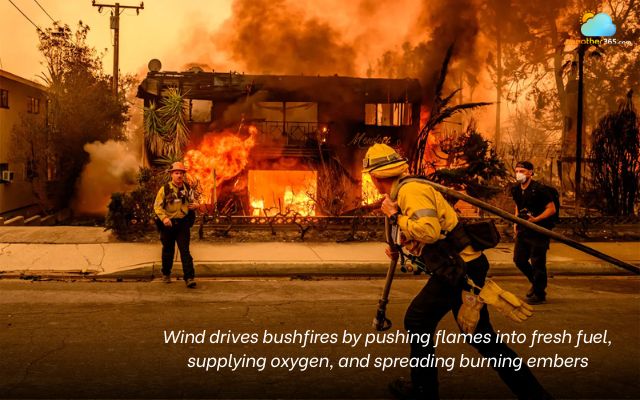
Wind speed drives bushfires more intensely
Ambient temperature
Higher temperatures increase the likelihood of fires starting or continuing to burn because fuel is closer to its ignition point.
Pre-heated vegetation and debris ignite more easily and burn faster, intensifying fire behavior.
Relative humidity
Dry air increases fire intensity compared to moist air because low humidity causes plants to lose moisture more quickly, making them more flammable and easier to ignite.
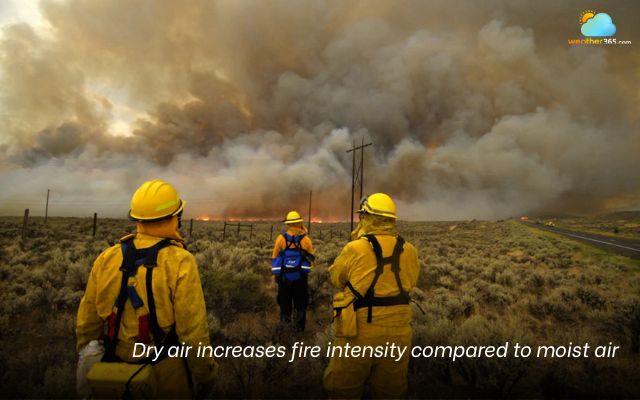
Low humidity increases the risk of wildfires
Slope angle
Fires preheat surrounding fuel through radiation and convection, causing them to move faster uphill and slower downhill.
Slope steepness significantly affects fire spread. The fire’s speed doubles for every 10° increase in slope.
It means that on a 20° slope, a fire can advance four times faster than on flat terrain.
Ignition source
Bushfires are caused by both natural factors (mainly lightning) and human activity (accidental ignitions and arson).
Fires near populated areas, often human-caused, pose greater risks to infrastructure, with arson especially dangerous during extreme fire weather conditions.
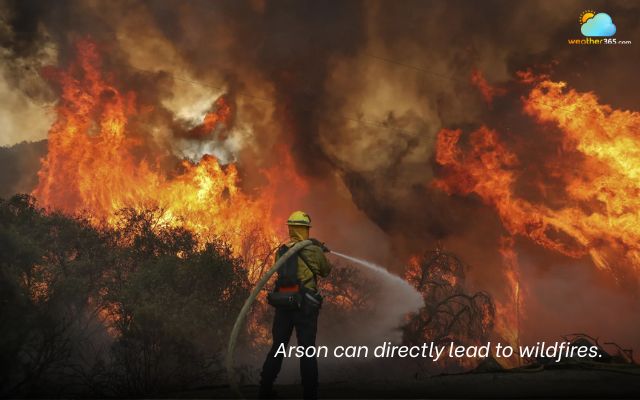
Some human activities, whether accidental or intentional, can be a trigger for wildfires
-
You may also like this: What causes bushfires in Australia?
Where do bushfires occur?
Bushfires occur in regions with hot, dry climates and abundant vegetation, where weather and environmental conditions create ideal fire risks.
They are most common in countries like Australia, known for its bushland and dry summers; the United States, particularly in states like California; and South Africa, where dry grasslands are widespread.
Bushfires also occur in parts of the Mediterranean, South America, and Southern Europe during seasonal droughts.
These fires often start in rural or forested areas but can threaten towns and cities when strong winds push flames toward populated regions.
Understanding where bushfires occur is crucial for improving prevention and emergency planning.
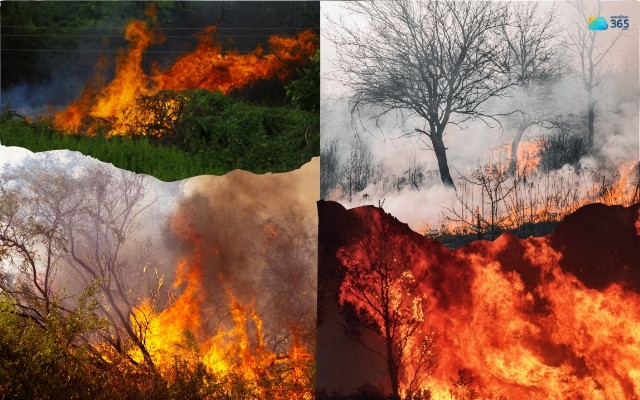
Bushfires occur in regions with hot, dry climates and abundant vegetation
Are bushfires natural?
Bushfires play an important role in many ecosystems and have been part of the natural cycle for millions of years.
They help eliminate harmful insects and diseases, burn dead or decaying debris, and return valuable nutrients to the soil.
This process creates open spaces, allowing new plants to grow and more sunlight to reach the ground.
Some plant species, such as Australia’s bottlebrush, even rely on fire to release seeds for regeneration.
Land managers often conduct controlled burns, carefully planned fires that safely reduce dry vegetation and help prevent large, out-of-control bushfires in the future.
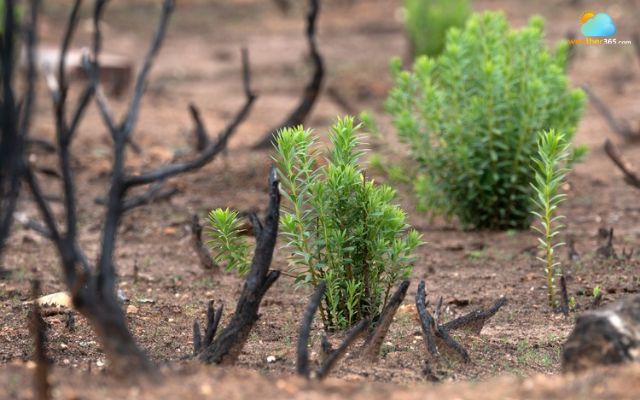
New growth after wildfires
Why are bushfires dangerous?
Bushfires become particularly hazardous when they spread toward populated areas, where they can damage homes, infrastructure, and the surrounding environment.
Smoke from these fires can impact air quality and lead to health risks, especially for people with respiratory conditions.
Fortunately, firefighters, emergency services, and local authorities work tirelessly to prevent and manage bushfires.
You and your family can also take some wildfire safety tips to stay safe, such as preparing an emergency kit, planning an evacuation route, and staying informed during high fire danger periods.
Being prepared is one of the most effective ways to reduce risks during a bushfire emergency.
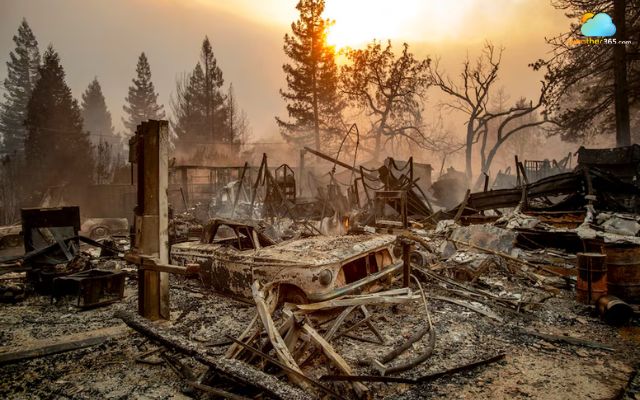
Bushfires are dangerous because they destroy homes and infrastructure
How to prevent bushfires?
The impact of Australian bushfires and other worldwide fires is huge. Effective fire management and prevention are crucial in vulnerable regions. This requires a combination of knowledge, a plan, and action.
Here are 5 ways you can prevent bushfires and protect your loved ones.
-
Implement strategic vegetation management
Effective vegetation management is essential for you to reduce bushfire risk and protect homes and communities.
Some good and effective actions you can do, such as
👉 Removing deadwood, underbrush, and other flammable materials
👉 Conducting controlled burns: Controlled burns with professional management will balance fire risk reduction and ecosystem health.
👉 Maintaining defensible spaces around properties: Creating strategic buffer zones around properties enhances fire safety. Ongoing maintenance and monitoring help prevent fuel buildup.
Bushfire protection experts can provide tailored guidance to ensure these methods align with local regulations and environmental conditions.
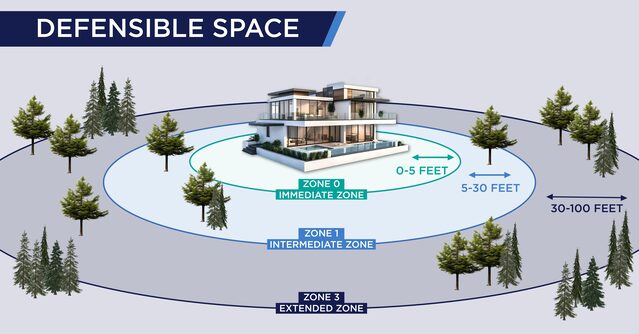
Create a defensible space around your house
-
Install firebreaks and protective barriers
Firebreaks and protective barriers play a vital role in bushfire prevention by slowing the spread of flames and protecting your property.
These strategically placed physical gaps in vegetation or combustible materials act as buffers that reduce the risk of fire reaching homes and assets.
Professional bushfire protection services can design and install firebreaks and barriers to maximize property defense while minimizing environmental impact.
Common techniques include:
👉 Clearing flammable vegetation
👉 Constructing land-based firebreaks
👉 Installing non-combustible materials
👉 Integrating water features
👉 Using fire-resistant landscaping
Regular maintenance and community collaboration are also essential for keeping firebreaks effective and supporting a comprehensive bushfire management strategy.
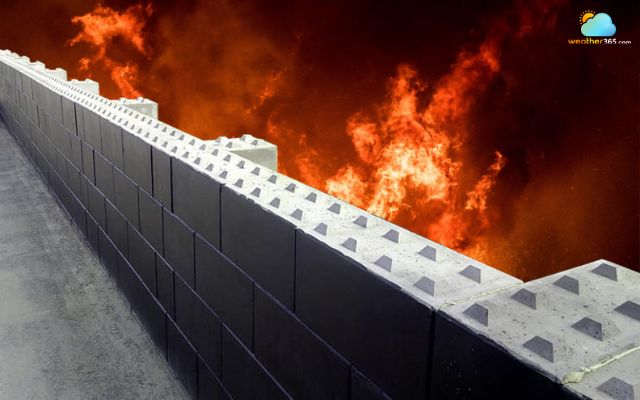
Install firebreaks and protective barriers for your house
-
Use advanced fire detection systems
Integrating advanced fire detection systems into your bushfire management plan is essential for early warning and rapid response.
Technologies like satellite monitoring and sensor networks can detect fires in real time.
Critical alerts help protect lives and property.
By installing satellite-based fire detection systems and placing sensor networks around your property, you can identify fire threats before they escalate.
Bushfire protection experts can assist in selecting and implementing the right technologies tailored to your location, ensuring optimal coverage and response capability.
Early detection is a key component of modern bushfire preparedness and significantly improves overall safety and resilience.
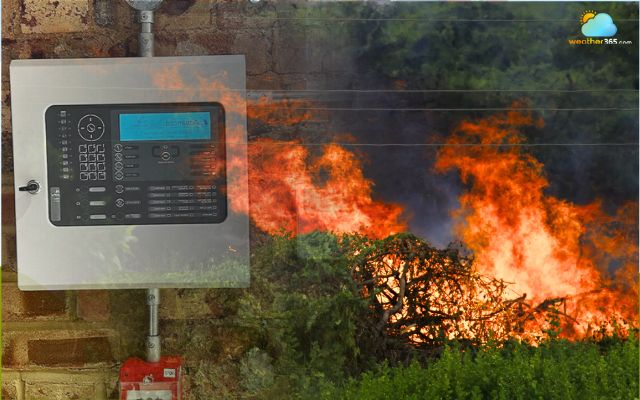
Install advanced fire detection systems
-
Use fire-resistant materials and designs
Selecting fire-resistant materials and designs is a crucial strategy for reducing bushfire risk.
Using materials that can withstand extreme heat, such as metal roofing, non-combustible cladding, and toughened glass.
These materials can significantly lower the chances of ignition during a fire.
Additionally, smart designs are also able to minimize fuel sources and improve defensible space, and help prevent bushfires from spreading to your property.
Let's consult with bushfire protection professionals. Ensure that you make informed decisions that comply with local regulations and maximize safety.
Smart construction choices are key to long-term bushfire protection and peace of mind.
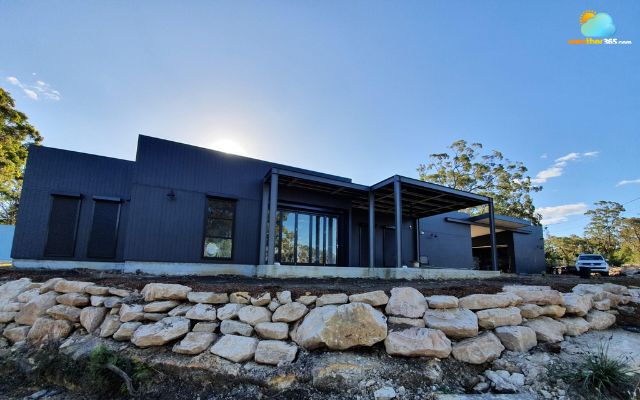
Consult experts to design smart home
-
Join a fire preparedness program
Community engagement in bushfire preparedness is vital for strengthening collective resilience and ensuring a swift, coordinated response to fire emergencies.
Through education initiatives, evacuation drills, and the formation of local response teams, communities can significantly reduce the risks associated with bushfires.
These efforts help residents understand bushfire hazards, prepare for potential threats, and act quickly when danger arises.
Bushfire protection experts support and train residents to enhance readiness.
By fostering a well-informed and prepared community, local areas are better equipped to protect lives, property, and the environment from bushfire threats.
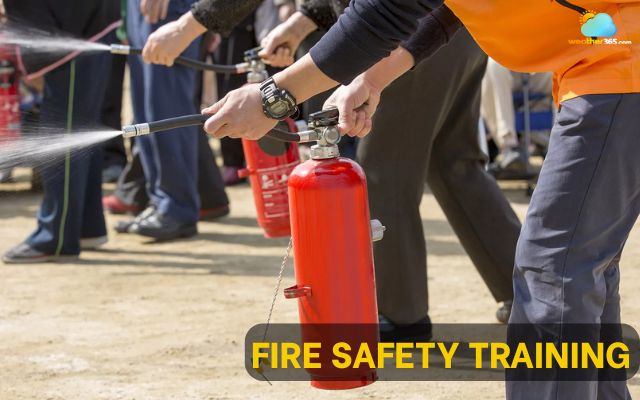
Fire safety training is vital
Also read: Top 10 worst bushfires in Australia
Conclusion
The impact of bushfires is wide-ranging, affecting forests, infrastructure, public health, and the climate system. As we have explored “What is a bushfire?”, contributing factors, and prevention tips, it’s imperative to take proactive actions to protect our environment and the safety of our communities.
Frequently Asked Questions (FAQs)
Related post
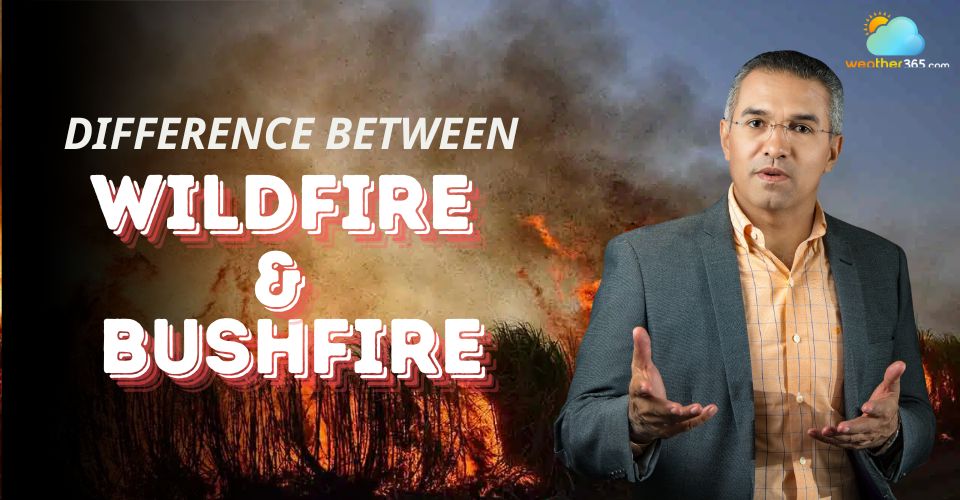

0 Comment
Leave a comment
Your email address will not be published. Required fields are marked *